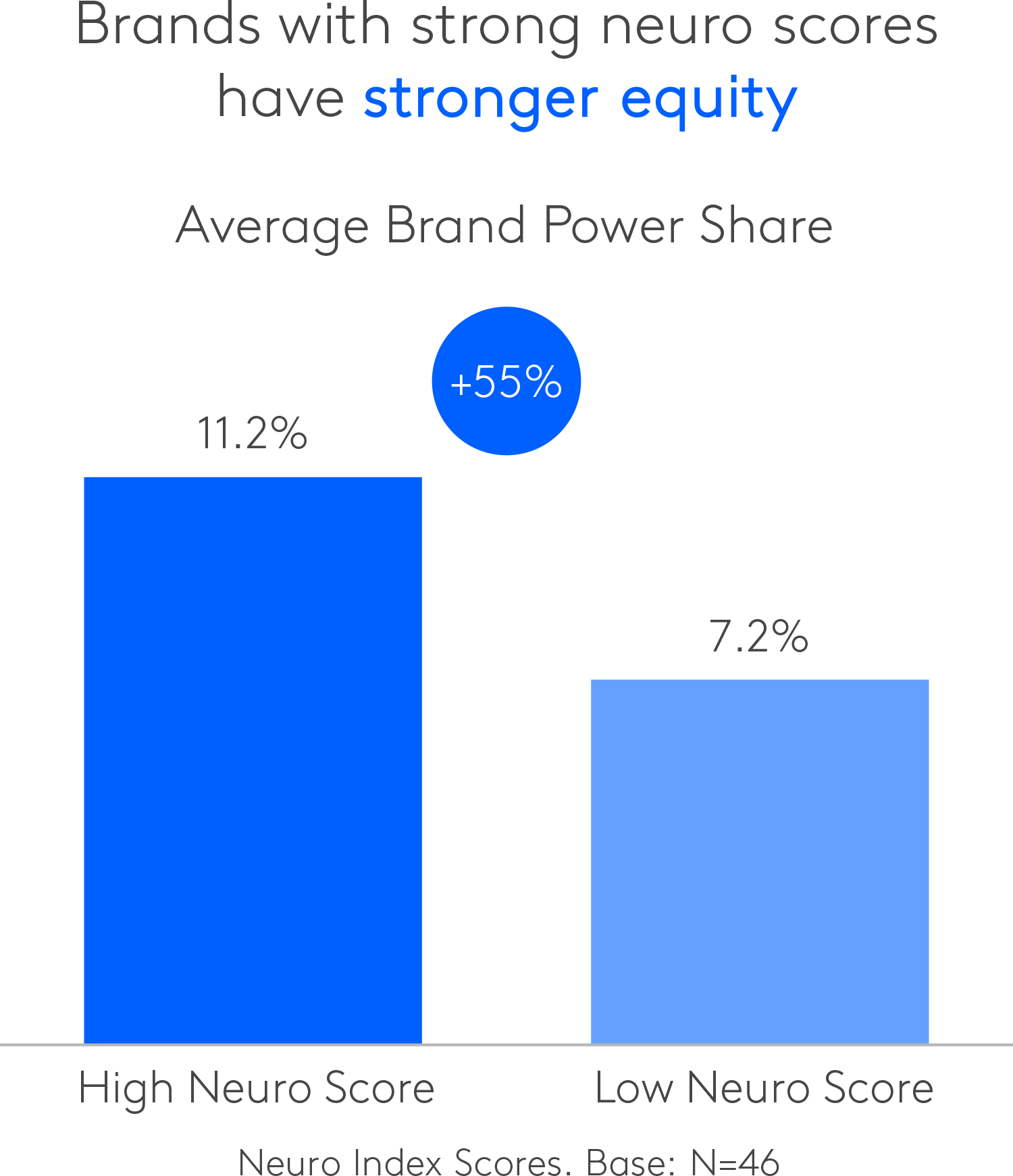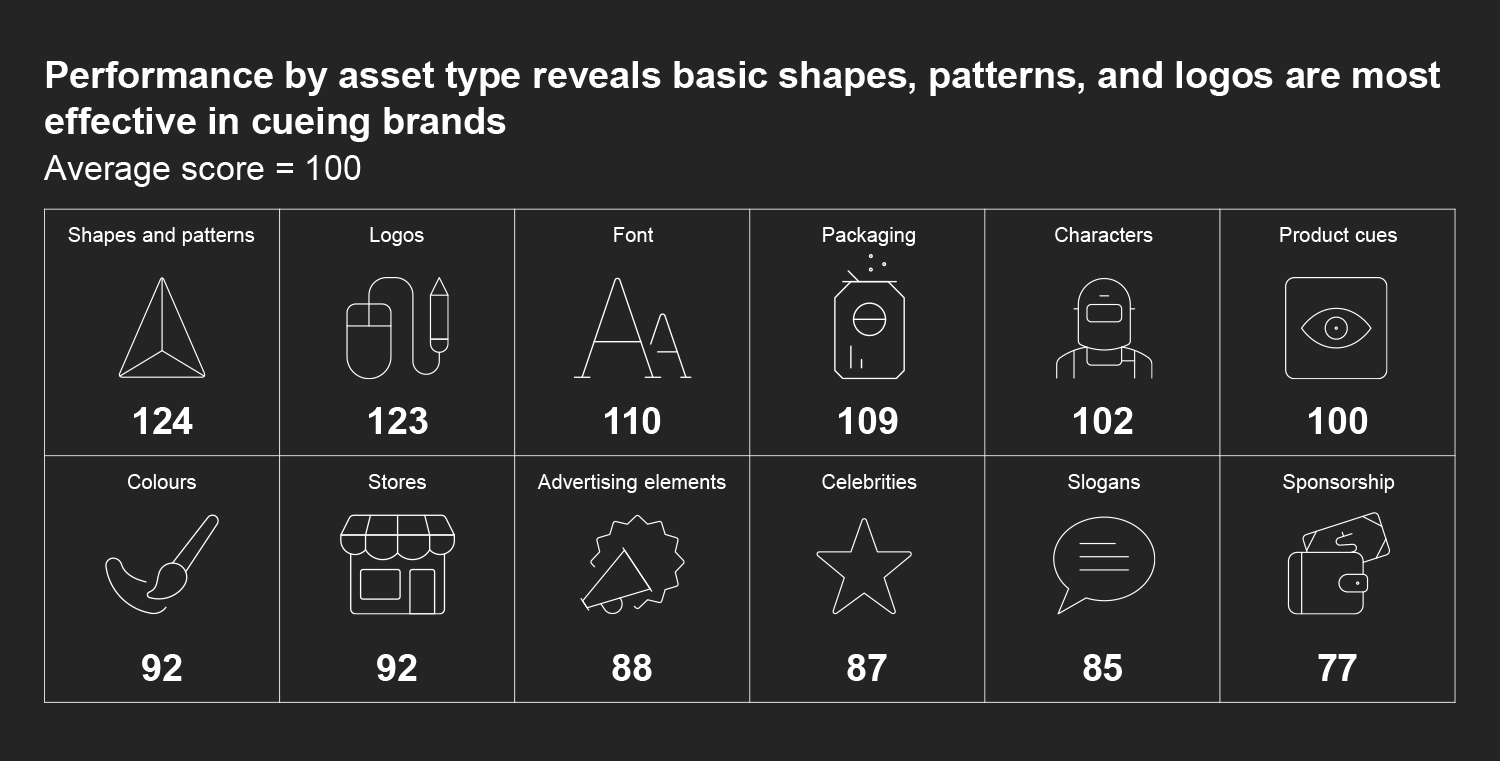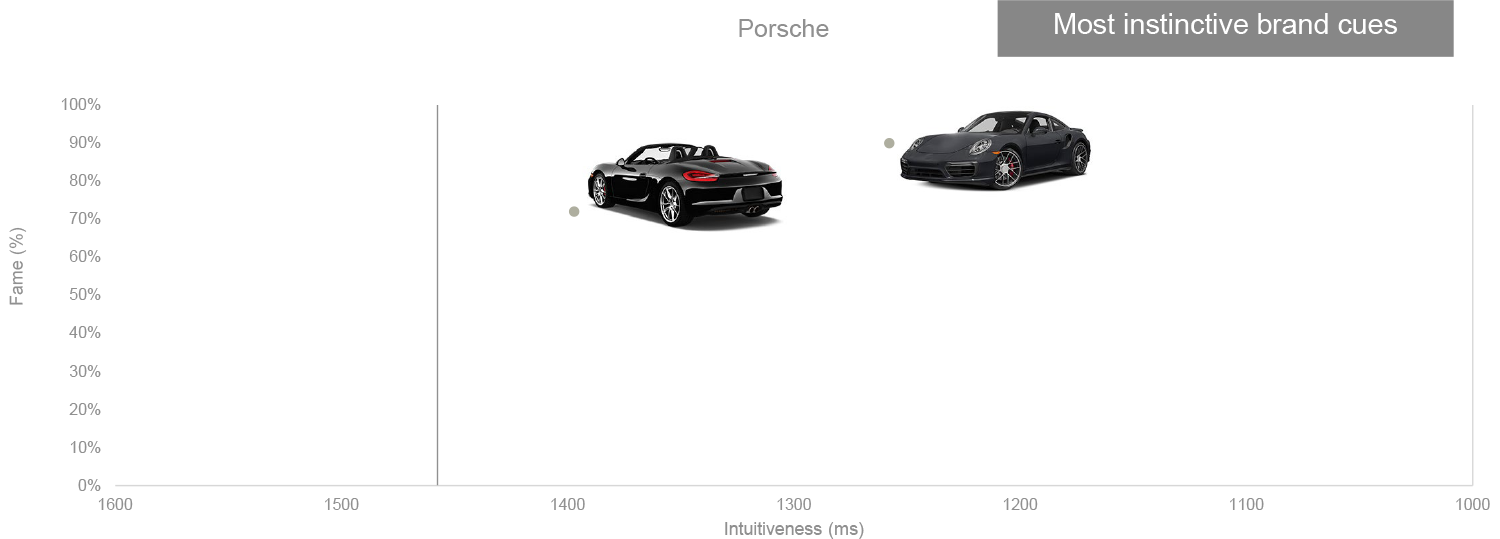In the first two articles in our series on brand equity, we looked at what brand equity is, and why and how you should measure it. In this article, we take a look at the behavioural science behind the brand associations people have in their minds that contribute to brand equity. We also outline the ways that you can build powerful brand cues that will drive more people to buy your brand.
So why should you care about strong brand assets? Because having strong brand cues increases your brand saliency by 52% and, perhaps even more importantly, results in a more valuable brand, and the ability to more than double your future growth prospects. In addition, Kantar’s Neuroscience research shows that brands strong on ‘Neuro’ indicators such as instinctive perceptions, emotional connection and brand imprint have a brand equity 55% higher than brands with low ‘Neuro’ indicators.

Gut feelings, the frequent drivers of brand choice, are built up of positive and negative associations with your brand, or, as Mary Kyriakidi astutely points out, your brand equity. But how can you strengthen your brand equity with subtle cues that resonate with your consumers, and lead to sales? We reveal five ways of building strong equity based on insights from analysis by our global Behavioural Science practice. We also share additional insights from NOVA, on how they have used brand cues to drive sales.
Are you wondering if we are going to mention emotions? After all, brand equity is a mould of positive and negative experiences. We will of course reveal the role of emotions as we discuss our recommendations, as this is inherent across all of them.
1. The need to belong
Since the Stone Age, we have had a strong desire to belong to a group, which, according to Professor Gad Saad, can be traced back to “one of four Darwinian overriding pursuits…reciprocity” (Saad, 2011, p. 14). This gives us safety and a comforting answer to ‘who am I?’ by identifying with the values of the group. You can reinforce a sense of belonging, and with that, solidify your brand equity, by cuing the idiosyncrasies of the different groups your audience belongs to and by clearly showing openness and a sense of care.
A prestigious brain imaging study has shown that the same brain area, the so called medial prefrontal cortex, gets activated both when we assess a ‘socially oriented brand’ and when we judge the intentions of people. This demonstrates the extraordinary influence of a brand: even our brain, beyond our conscious awareness, may see brands as powerful as the influence of our friends. Thus a ‘caring’ brand may be as strong in influencing consumers’ behaviour as a conversation with consumers’ friends.
Many consumers want to belong to the Apple tribe, and one of the cues of Apple’s brand equity is their open-plan stores. They also display photographs taken by people from all over the world, conveying a truly global community.
Establishing a sense of belonging has a pleasant by-product too: it creates positive associations and experiences, the essence of brand equity. Belonging to a group increases consumers’ self-esteem, which makes them feel balanced, confident and carefree.
All in all, by creating a sense of belonging, you have elicited positive feelings and experiences, ultimately strengthening your brand equity.
2. Aspirations
As much as we like to belong, we are also motivated to achieve internal growth, as posited in the paper on Self-Determination Theory by Professor E.L. Deci and R.M. Ryan. We can work towards this growth by being in control of our choices (i.e. autonomy), by becoming good at certain things (i.e. competence), and also by feeling loved (i.e. relatedness).
Your brand can help your consumers’ inner growth by offering a lifestyle your consumers can achieve (autonomy), or a skill they can learn (competence), or a happy relationship they can establish (relatedness). One of our recent studies combined insights from our BrandZ database and intuitive associations exploration tool, which uses neuroscience techniques to analyse the ideas people intuitively and immediately associate with a brand, and those which only come to mind when thinking harder about a brand. The study showed that when directly asked, customers don’t regard financial institutions as enabling their autonomy. However, their instinctive perceptions of the financial institution category, teased out with our neuroscience method, are that of reassurance, a sense of being in control.
Nike does not claim that their sports gear will make consumers the next world champion. However, it does assure consumers that with their trainers, they will be able to run even faster, increasing their competence. Patek Philippe conveys the idea that you never actually own one of their watches; you merely look after it for the next generation. This passing down from generation to generation creates a strong sense of connectedness.
Being in control makes consumers feel free, their competence makes them beam with pride and positive relationships trigger compassion. What you have achieved by tapping into consumers’ inner growth, eliciting positive behaviours and emotions is building another layer of brand equity.
When one of our financial services clients wanted to introduce a new product, they were keen to test how it would be perceived before launching, to ensure it met their aspirations. Using Kantar’s intuitive associations exploration tool, our client was able to explore the product’s ‘instant meaning’. The analysis showed that the product triggered deeply rooted perceptions of ‘modernity’, ‘comfort’ and ‘safety’, which was exactly in line with the brand’s intentions, and our client was able to confidently introduce the new product knowing that it would help strengthen their brand equity.
3. Personal memories
A powerful way of building positive predispositions for your brand is by tapping into your consumers’ personal memories. The power of personal (also known as autobiographical) memories lies in the fact that they connect a wide array of sensations and experiences, such as your trying on your grandma’s heirloom necklace, the lavender scent of the room, the soothing sensation of touching the pearl, and the loud chirping of the birds outside.
You can tap into your consumers’ nostalgia through product features: for example, using pearl will remind your audience of their grandma’s necklace. You can also reinforce personal memories through your storytelling, by placing your brand in a 1920s scenario on a print or in digital advertising.
This ‘nostalgic’ brand positioning increases brand equity by creating emotional attachment to the brand by taking the audience back to the past when ‘everything was better’. In addition, brands that create such positive dispositions are also seen more authentic. Nostalgic brands can also replace real social connections, thereby becoming as strong an emotional support as one of consumers’ loved ones.
Lacoste’s ‘Timeless’ advertisement takes the audience back to the 1930s, evoking memories of their grandma sharing stories of her first love affair, her fierce fight with her parents over her engagement, and the decadent wedding they eventually had.
One of our automotive clients, owning a strong ‘traditional’ brand equity, wanted to modernise their brand through upbeat music in their advertisement. Using Kantar’s intuitive associations exploration tool and Link ad testing our client was able to confirm that this attempt would have failed: the audience still preferred the brand that took them back to the peaceful and comforting past. As a result, the client continued to use their ‘nostalgic’ auditory cues to maintain their existing brand equity.
4. The power of design
Brand assets such as shapes and patterns can evoke strong predispositions and become a powerful route towards strengthening your brand equity. One of our recent studies combined insights from our BrandZ database and brand asset optimisation tool, which accesses intuitive responses to understand which brand assets uniquely bring a brand to mind. The study found that alongside logos, shapes and patterns are the strongest assets (please see chart) simply because our brains are on a hunt for shortcuts (heuristics) to lighten the cognitive load.
The magic of such, seemingly tiny brand cues lies, partly, in how our memory works. The moment people detect your brand assets, even if they are not consciously aware of noticing them, neurons start to fire. Emotions, triggered by your assets, as well as real or imagined sensations (such as smell or touch) help forging your asset in consumers’ brain. The work in the memory continues, and the asset may become part of consumers’ short-term and even long-term memory. In addition, different facets of your brand cues leach onto different nodes in our spider-web like memory, which further strengthens the power of your brand: the colour of your asset may trigger the colour of consumers’ mother’s eyes, which may then evoke the love for their mum, and so forth.
Meeting your brand cues through various experiences and touchpoints engrains your brand asset in consumers’ memory even more. This, then can increase the likelihood of consumers choosing your brand over the competition.

*Based on 228 brands, 28 categories, 1390 assets
Furthermore, studies have shown that shapes evoke emotions. For example, one study found that curved and less complex shapes in general are more likely to lead to positive feelings.
In addition, the sheer act of imagining touching materials, for example, steel, wood, metal, creates a sense of ownership; your consumer already feels as if they own your brand. This sense of ownership, or endowment, also means they don’t want to lose you, they insist on you like a wolf on its prey.
Chanel’s 55.5 necklace is not only made of white gold and diamonds, but its ‘pendant’ is the shape of their Chanel No 5 perfume bottle. The shape of Porsche’s 911 is not only iconic but is also a strong and instinctive brand cue – as seen in the graph.
Porsche 911 is an instinctive asset driven by its shape

A word of caution: even though shapes are the strongest brand cues, it is not guaranteed they will work for your brand. One of our clients within a highly aspirational category felt confident they had strong assets; however, they decided it was time to put the assets to the test. Using our brand asset optimisation tool, they were able to see that while their logo was indeed a strong and distinctive asset, most of their other assets, including shapes, were mixed up with their competitor. We therefore suggested the client never use their brand assets, bar the logo, independently, out of context, as they were likely to benefit their competitor.
5. Emotions
What about emotions, you ask? We clearly need emotions to strengthen brand equity. After all, the ancient part of our brain, the limbic system, orchestrates memory, emotions and behaviour. The truth is though, that emotions will spark alongside the recommendations, as we have demonstrated above.
As Professor Saad says in his book, The Parasitic Mind, “We are both thinking and feeling animals. The challenge is to know when to activate the cognitive (thinking) versus the affective (feeling) systems” (Saad, 2020, p. 23-24). Separating emotions from thoughts is arbitrary and has no use in shaping consumer behaviour. Reflecting the scientific viewpoint, at Kantar we fuse our thinking (Type 2) and feeling (Type 1) measurements: our neuroscience methods reveal feelings, emotions, hard-to-articulate perceptions, which we integrate with what consumers said and thought in our surveys.
Insights from Kantar’s recent Creative Effectiveness Awards have also revealed that triggering an emotional response is one of the five habits of the most successful advertisers: “Making the viewer feel something wins engagement for the ad, bypassing the natural tendency to screen out advertising” having “positive effects on the brand’s emotional associations.”
How NOVA built strong brand cues to drive sales
NOVA, the brand behind the earpiece which also doubles as wireless earphones, achieved 100% funding within one hour of its launch. Many of the cues that NOVA used to build strong brand assets reflect the four routes of building positive brand associations we described:
- The ‘need to belong’: In visual branding, NOVA uses models that represent the diversity of different consumers
- ‘Aspirations’: The materials used, silver or gold and pearls, are perceived as high quality and when the user is wearing it, they feel their social status elevated
- ‘Nostalgic memories’: the pearl might evoke memories from the audience’s childhood, remembering their grandma’s pearl earrings and all the positive emotions with that
- The ‘psychological power of design’:
- NOVA chose pearl because the circular shape represents wholeness and original perfection. In addition, the jewel – silver and gold – evokes tradition and elegance
- In the design, NOVA tried to stay away from edgy corners since these represent rigidity and go against the premise that tech flows, changes, evolves
- The colour palette of the brand, green, aubergine and yellow mustard, denotes luxury, strong and vibrant personality.
How do you know if you have done a good job?
How do you know if you have built strong brand cues that will contribute to the strength of your brand equity? A safe way of knowing this is measurement, and by using our neuroscience techniques, such as intuitive associations exploration and brand asset optimisation, within the right brand guidance system, will help you make informed decisions for brand growth. Do get in touch if you would like to find out more, or discuss how you can strengthen your brand cues to drive sales and strengthen your brand equity.
This is the third of a series of articles that explore the theme of brand equity covering what it is, how to measure it, how to build it, the impact of media investment on it, the role of brand positioning as a solid foundation, all of which contribute (or should at least) to the making of one’s brand strategy. Take a look at the two previous articles below to find out what brand equity is, and why and how you should measure it, and look out for the next article in the series, coming soon.

